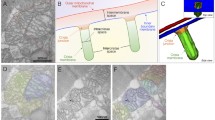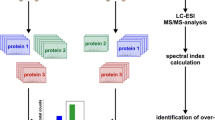Abstract
Myofibrillar myopathies (MFMs) are rare inherited or sporadic progressive neuromuscular disorders with considerable clinical and genetic heterogeneity. In the current study, we have analyzed histopathological and immunohistochemical characteristics in genetically identified MFMs. We performed a morphological and morphometrical study in a cohort of 24 genetically identified MFM patients (12 desmin, 6 αB-crystallin, 4 ZASP, 2 myotilin), and an extensive immunohistochemical study in 15 of these patients, using both well-known and novel antibodies directed against distinct compartments of the muscle fibers, including Z-disc and M-band proteins. Our morphological data revealed some significant differences between the distinct MFM subgroups: the consistent presence of ‘rubbed-out’ fibers in desminopathies and αB-crystallinopathies, an elevated frequency of vacuoles in ZASPopathies and myotilinopathies, and the presence of a few necrotic fibers in the two myotilinopathy patients. Immunohistochemistry showed that in MFM only a subset of Z-disc proteins, such as filamin C and its ligands myotilin and Xin, exhibited significant alterations in their localization, whereas other Z-disc proteins like α-actinin, myopodin and tritopodin, did not. In contrast, M-band proteins revealed no abnormalities in MFM. We conclude that the presence of ‘rubbed-out’ fibers are a suggestive feature for desminopathy or αB-crystallinopathy, and that MFM is not a general disease of the myofibril, but primarily affects a subgroup of stress-responsive Z-disc proteins.




Similar content being viewed by others
References
Baeta AM, Figarella-Branger D, Bille-Turc F, Lepidi H, Pellissier JF (1996) Familial desmin myopathies and cytoplasmic body myopathies. Acta Neuropathol 92:499–510. doi:10.1007/s004010050552
Bohlega S, Lach B, Meyer BF et al (2003) Autosomal dominant hyaline body myopathy: clinical variability and pathologic findings. Neurology 61:1519–1523
Brooke MH, Engel WK (1969) The histographic analysis of human muscle biopsies with regard to fiber types 1. Adult male and female. Neurology 19:221–233
Choi S, Gustafson-Wagner EA, Wang Q et al (2007) The intercalated disk protein, mXinalpha, is capable of interacting with beta-catenin and bundling actin filaments. J Biol Chem 282:36024–36036. doi:10.1074/jbc.M707639200
Claeys KG, Fardeau M, Schröder R et al (2008) Electron microscopy in myofibrillar myopathies reveals clues to the mutated gene. Neuromuscul Disord 18:656–666. doi:10.1016/j.nmd.2008.06.367
Davies KE, Nowak KJ (2006) Molecular mechanisms of muscular dystrophies: old and new players. Nat Rev Mol Cell Biol 7:762–773. doi:10.1038/nrm2024
De Bleecker J, Engel AG, Ertl BB (1996) Myofibrillar myopathy with abnormal foci of desmin positivity II. Immunocytochemical analysis reveals accumulation of multiple other proteins. J Neuropathol Exp Neurol 55:563–577. doi:10.1097/00005072-199605000-00009
Dubowitz V, Sewry CA (2007) Muscle biopsy: a practical approach, 3rd edn. Elsevier, London
Fardeau M, Godet-Guillain J, Tome FM et al (1978) A new familial muscular disorder demonstrated by the intra-sarcoplasmic accumulation of a granulo-filamentous material which is dense on electron microscopy. Rev Neurol (Paris) 134:411–425 in French
Faulkner G, Pallavicini A, Formentin E et al (1999) ZASP: a new Z-band alternatively spliced PDZ-motif protein. J Cell Biol 146:465–475
Fayet G, Rouche A, Hogrel JY, Tomé FM, Fardeau M (2001) Age-related morphological changes of the deltoid muscle from 50 to 79 years of age. Acta Neuropathol 101:358–366
Frank D, Kuhn C, Katus HA, Frey N (2006) The sarcomeric Z-disc: a nodal point in signalling and disease. J Mol Med 84:446–468
Frey N, Barrientos T, Shelton JM et al (2004) Mice lacking calsarcin-1 are sensitized to calcineurin signaling and show accelerated cardiomyopathy in response to pathological biomechanical stress. Nat Med 10:1336–1343
Fukuzawa A, Lange S, Holt M et al (2008) Interactions with titin and myomesin target obscurin and obscurin-like 1 to the M-band: implications for hereditary myopathies. J Cell Sci 121:1841–1851
Fürst DO, Osborn M, Nave R, Weber K (1988) The organization of titin filaments in the half-sarcomere revealed by monoclonal antibodies in immunoelectron microscopy: a map of ten nonrepetitive epitopes starting at the Z line extends close to the M line. J Cell Biol 106:1563–1572
Goldfarb LG, Park KY, Cervenakova L et al (1998) Missense mutations in desmin associated with familial cardiac and skeletal myopathy. Nat Genet 19:402–403
Gontier Y, Taivainen A, Fontao L et al (2005) The Z-disc proteins myotilin and FATZ-1 interact with each other and are connected to the sarcolemma via muscle-specific filamins. J Cell Sci 118:3739–3749
Griggs R, Vihola A, Hackman P et al (2007) Zaspopathy in a large classic late-onset distal myopathy family. Brain 130:1477–1484
Hauser MA, Horrigan SK, Salmikangas P et al (2000) Myotilin is mutated in limb girdle muscular dystrophy 1A. Hum Mol Genet 9:2141–2147
Hawke TJ, Atkinson DJ, Kanatous SB, van der Ven PFM, Goetsch SC, Garry DJ (2007) Xin, an actin binding protein, is expressed within muscle satellite cells and newly regenerated skeletal muscle fibers. Am J Physiol Cell Physiol 293:C1636–C1644
Hijikata T, Murakami T, Imamura M, Fujimaki N, Ishikawa H (1999) Plectin is a linker of intermediate filaments to Z-discs in skeletal muscle fibers. J Cell Sci 112:867–876
Hijikata T, Murakami T, Ishikawa H, Yorifuji H (2003) Plectin tethers desmin intermediate filaments onto subsarcolemmal dense plaques containing dystrophin and vinculin. Histochem Cell Biol 119:109–123
Huang HT, Brand OM, Mathew M et al (2006) Myomaxin is a novel transcriptional target for MEF2A that encodes a Xin related alpha-actinin interacting protein. J Biol Chem 281:39370–39379
Kley RA, Hellenbroich Y, van der Ven PFM et al (2007) Clinical and morphological phenotype of the filamin myopathy: a study of 31 German patients. Brain 130:3250–3264
Knöll R, Hoshijima M, Hoffman HM et al (2002) The cardiac mechanical stretch sensor machinery involves a Z-disc complex that is defective in a subset of human dilated cardiomyopathy. Cell 111:943–955
Li Z, Colucci-Guyon E, Pinçon-Raymond M et al (1996) Cardiovascular lesions and skeletal myopathy in mice lacking desmin. Dev Biol 175:362–366
Milner DJ, Mavroidis M, Weisleder N, Capetanaki Y (2000) Desmin cytoskeleton linked to muscle mitochondrial distribution and respiratory function. J Cell Biol 150:1283–1298
Nakano S, Engel AG, Akiguchi I, Kimura J (1997) Myofibrillar myopathy III. Abnormal expression of cyclin-dependent kinases and nuclear proteins. J Neuropathol Exp Neurol 56:850–856
Nakano S, Engel AG, Waclawik AJ, Emslie-Smith AM, Busis NA (1996) Myofibrillar myopathy with abnormal foci of desmin positivity I. Light and electron microscopy analysis of 10 cases. J Neuropathol Exp Neurol 55:549–562
Olivé M, Goldfarb LG, Shatunov A, Fischer D, Ferrer I (2005) Myotilinopathy: refining the clinical and myopathological phenotype. Brain 128:2315–2326
Pacholsky D, Vakeel P, Himmel M et al (2004) Xin repeats define a novel actin-binding motif. J Cell Sci 117:5257–5268
Pénisson-Besnier I, Talvinen K, Dumez C et al (2006) Myotilinopathy in a family with late onset myopathy. Neuromuscul Disord 16:427–431
Poon E, Howman EV, Newey SE, Davies KE (2002) Association of syncoilin and desmin: linking intermediate filament proteins to the dystrophin-associated protein complex. J Biol Chem 277:3433–3439
Quinzii CM, Vu TH, Min KC et al (2008) X-linked dominant scapuloperoneal myopathy is due to a mutation in the gene encoding four-and-a-half-LIM protein 1. Am J Hum Genet 82:208–213
Reimann J, Kunz WS, Vielhaber S, Kappes-Horn K, Schröder R (2003) Mitochondrial dysfunction in myofibrillar myopathy. Neuropathol Appl Neurobiol 29:45–51
Rezniczek GA, Konieczny P, Nikolic B et al (2007) Plectin 1f scaffolding at the sarcolemma of dystrophic (mdx) muscle fibers through multiple interactions with beta-dystroglycan. J Cell Biol 176:965–977
Salmikangas P, Mykkänen OM, Grönholm M, Heiska L, Kere J, Carpén O (1999) Myotilin, a novel sarcomeric protein with two Ig-like domains, is encoded by a candidate gene for limb-girdle muscular dystrophy. Hum Mol Genet 8:1329–1336
Schröder R, Goudeau B, Simon MC et al (2003) On noxious desmin: functional effects of a novel heterozygous desmin insertion mutation on the extrasarcomeric desmin cytoskeleton and mitochondria. Hum Mol Genet 12:657–669
Selcen D (2008) Myofibrillar myopathies. Curr Opin Neurol 21:585–589
Selcen D, Engel AG (2003) Myofibrillar myopathy caused by novel dominant negative alphaB-crystallin mutations. Ann Neurol 54:804–810
Selcen D, Engel AG (2004) Mutations in myotilin cause myofibrillar myopathy. Neurology 62:1363–1371
Selcen D, Engel AG (2005) Mutations in ZASP define a novel form of muscular dystrophy in humans. Ann Neurol 57:269–276
Selcen D, Ohno K, Engel AG (2004) Myofibrillar myopathy: clinical, morphological and genetic studies in 63 patients. Brain 127:439–451
Sinn HW, Balsamo J, Lilien J, Lin JJ (2002) Localization of the novel Xin protein to the adherens junction complex in cardiac and skeletal muscle during development. Dev Dyn 225:1–13
Thompson TG, Chan YM, Hack AA et al (2000) Filamin 2 (FLN2): a muscle-specific sarcoglycan interacting protein. Cell Biol 148:115–126
van der Ven PFM, Ehler E, Vakeel P et al (2006) Unusual splicing events result in distinct Xin isoforms that associate differentially with filamin C and Mena/VASP. Exp Cell Res 312:2154–2167
van der Ven PFM, Obermann WMJ, Lemke B, Gautel M, Weber K, Fürst DO (2000) Characterization of muscle filamin isoforms suggests a possible role of gamma-filamin/ABP-L in sarcomeric Z-disc formation. Cell Motil Cytoskeleton 45:149–162
van der Ven PFM, Wiesner S, Salmikangas P et al (2000) Indications for a novel muscular dystrophy pathway. gamma-filamin, the muscle-specific filamin isoform, interacts with myotilin. J Cell Biol 151:235–248
Vicart P, Caron A, Guicheney P et al (1998) A missense mutation in the alphaB-crystallin chaperone gene causes a desmin-related myopathy. Nat Genet 20:92–95
Vinkemeier U, Obermann W, Weber K, Fürst DO (1993) The globular head domain of titin extends into the center of the sarcomeric M band. cDNA cloning, epitope mapping and immunoelectron microscopy of two titin-associated proteins. J Cell Sci 106:319–330
Vorgerd M, van der Ven PFM, Bruchertseifer V et al (2005) A mutation in the dimerization domain of filamin C causes a novel type of autosomal dominant myofibrillar myopathy. Am J Hum Genet 77:297–304
Weins A, Schwarz K, Faul C, Barisoni L, Linke WA, Mundel P (2001) Differentiation- and stress-dependent nuclear cytoplasmic redistribution of myopodin, a novel actin-bundling protein. J Cell Biol 155:393–404
Acknowledgments
We are very thankful to Maud Beuvin, Guy Brochier, Mai-Thao Bui, Emmanuelle Lacène, Linda Manéré and Andrée Rouche for their excellent technical support. GF was supported by Grant GGP04088 from the Telethon Foundation-Italy. DF was supported by a grant from the Deutsche Forschungsgemeinschaft. DF and PvdV are members of the German network on muscular dystrophies (MD-NET) funded by the German Ministry of Education and Research (BMBF, Bonn, Germany). The PV team was supported by grant ANR-06-MRAR-03901 and research contract no 12986 from the Association Française contre les Myopathies.
Conflict of interest statement
The authors declare that they have no conflict of interest.
Author information
Authors and Affiliations
Corresponding author
Electronic supplementary material
Below is the link to the electronic supplementary material.
401_2008_479_MOESM1_ESM.ppt
Supplementary Fig.1: Immunostainings in myotilinopathies. (a-q) Serial transverse sections in myotilin-mutated patient 24. Wide variability in fiber size, internal nuclei, fiber splitting, vacuoles, aggregates and increased interstitial collagen are observed in HE (a) and TRI (b) stained sections. An abnormal staining pattern is found with antibodies against myotilin (c), desmin (d), XinR (e), XinC (f), filamin C (g), ZASP (h), and NCAM (i). (j-n) A normal to very weak abnormal, diffuse staining pattern was observed using antibodies against myopodin (j-k), tritopodin (l), α-actinin (m) and M-protein (n). (o) Ectopic intrasarcoplasmic expression of dystrophin within several fibers is shown, sometimes with (fiber 2) and sometimes without (fiber 1) the presence of vacuoles. An abnormally enhanced staining pattern is also revealed using the antibody against XIRP2 (p-q), shown at a non-serial section. Numbers (1) and (2) indicate the corresponding affected fibers in serial sections. Bars correspond to 100 μm. (PPT 39319 kb)
Rights and permissions
About this article
Cite this article
Claeys, K.G., van der Ven, P.F.M., Behin, A. et al. Differential involvement of sarcomeric proteins in myofibrillar myopathies: a morphological and immunohistochemical study. Acta Neuropathol 117, 293–307 (2009). https://doi.org/10.1007/s00401-008-0479-7
Received:
Revised:
Accepted:
Published:
Issue Date:
DOI: https://doi.org/10.1007/s00401-008-0479-7




